Critical Reflections on the History of Modern China: An Essay
VerifiedAdded on 2023/06/03
|14
|4141
|404
Essay
AI Summary
This assignment consists of six reflective papers analyzing key topics in modern Chinese history. The papers cover China's interactions with the outside world during the Opium Wars, the rise of Anti-Manchu Nationalism and its role in revolution, China's policy of peaceful rise, and the influence of Maois...
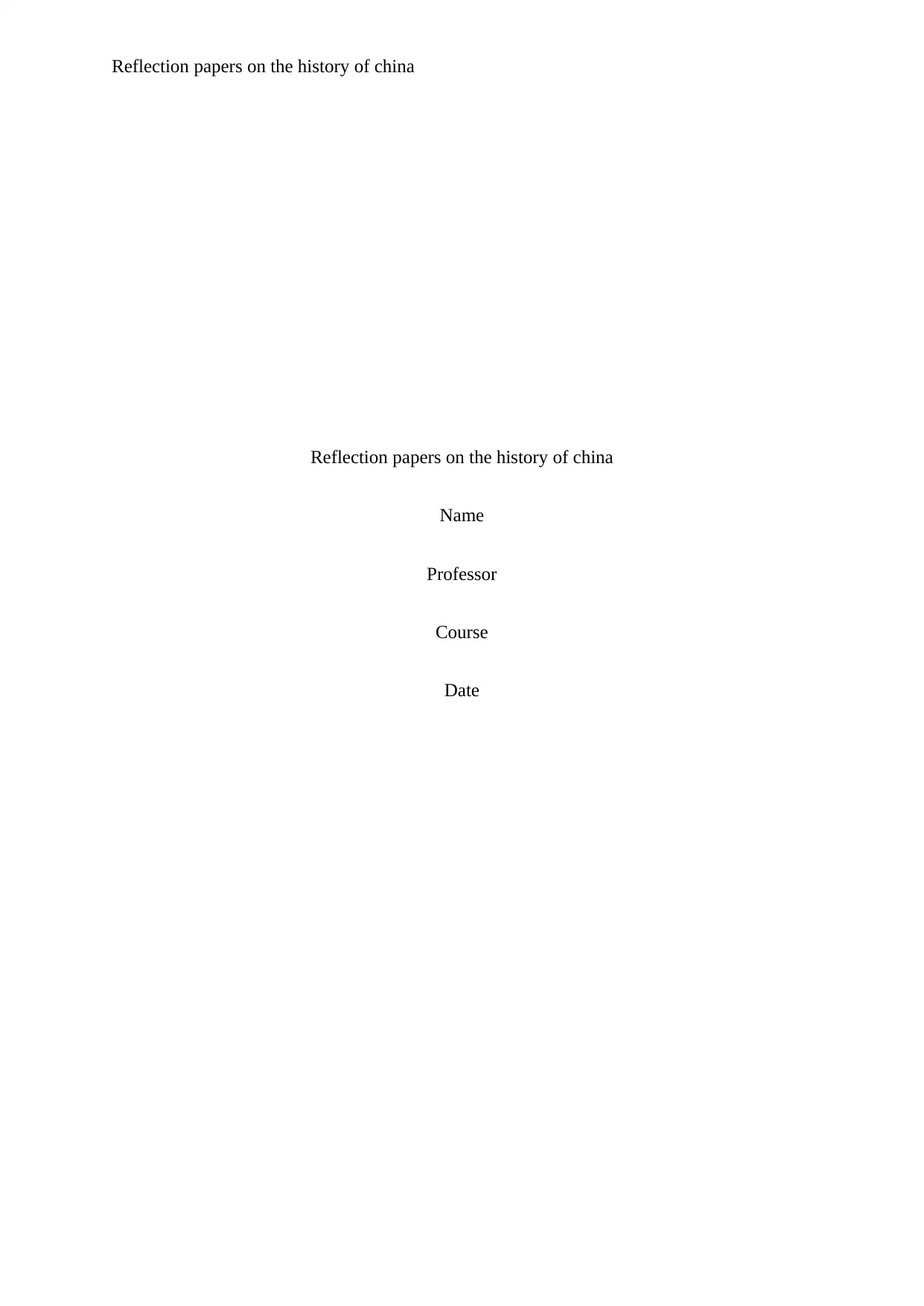
Reflection papers on the history of china
Reflection papers on the history of china
Name
Professor
Course
Date
Reflection papers on the history of china
Name
Professor
Course
Date
Paraphrase This Document
Need a fresh take? Get an instant paraphrase of this document with our AI Paraphraser
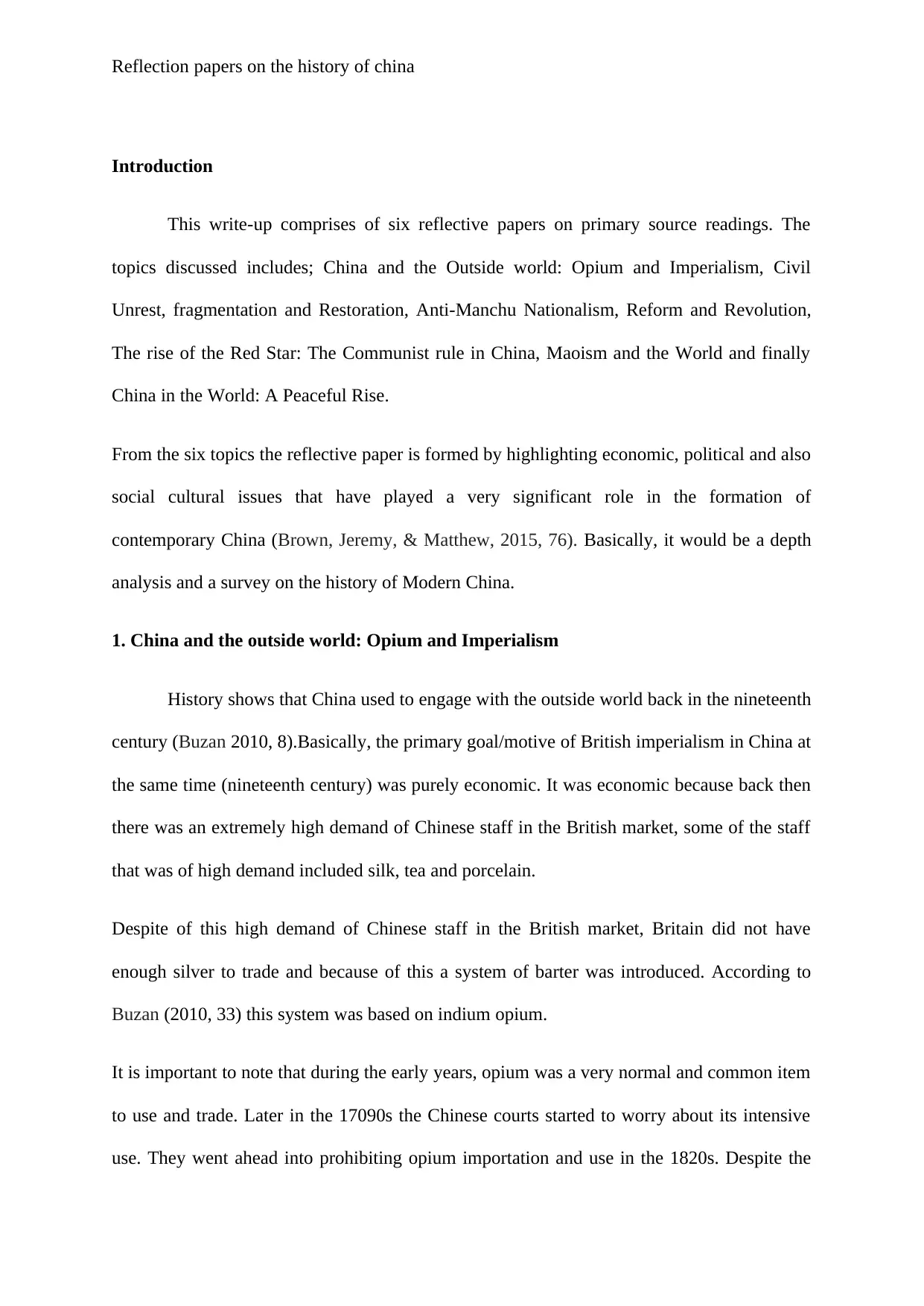
Reflection papers on the history of china
Introduction
This write-up comprises of six reflective papers on primary source readings. The
topics discussed includes; China and the Outside world: Opium and Imperialism, Civil
Unrest, fragmentation and Restoration, Anti-Manchu Nationalism, Reform and Revolution,
The rise of the Red Star: The Communist rule in China, Maoism and the World and finally
China in the World: A Peaceful Rise.
From the six topics the reflective paper is formed by highlighting economic, political and also
social cultural issues that have played a very significant role in the formation of
contemporary China (Brown, Jeremy, & Matthew, 2015, 76). Basically, it would be a depth
analysis and a survey on the history of Modern China.
1. China and the outside world: Opium and Imperialism
History shows that China used to engage with the outside world back in the nineteenth
century (Buzan 2010, 8).Basically, the primary goal/motive of British imperialism in China at
the same time (nineteenth century) was purely economic. It was economic because back then
there was an extremely high demand of Chinese staff in the British market, some of the staff
that was of high demand included silk, tea and porcelain.
Despite of this high demand of Chinese staff in the British market, Britain did not have
enough silver to trade and because of this a system of barter was introduced. According to
Buzan (2010, 33) this system was based on indium opium.
It is important to note that during the early years, opium was a very normal and common item
to use and trade. Later in the 17090s the Chinese courts started to worry about its intensive
use. They went ahead into prohibiting opium importation and use in the 1820s. Despite the
Introduction
This write-up comprises of six reflective papers on primary source readings. The
topics discussed includes; China and the Outside world: Opium and Imperialism, Civil
Unrest, fragmentation and Restoration, Anti-Manchu Nationalism, Reform and Revolution,
The rise of the Red Star: The Communist rule in China, Maoism and the World and finally
China in the World: A Peaceful Rise.
From the six topics the reflective paper is formed by highlighting economic, political and also
social cultural issues that have played a very significant role in the formation of
contemporary China (Brown, Jeremy, & Matthew, 2015, 76). Basically, it would be a depth
analysis and a survey on the history of Modern China.
1. China and the outside world: Opium and Imperialism
History shows that China used to engage with the outside world back in the nineteenth
century (Buzan 2010, 8).Basically, the primary goal/motive of British imperialism in China at
the same time (nineteenth century) was purely economic. It was economic because back then
there was an extremely high demand of Chinese staff in the British market, some of the staff
that was of high demand included silk, tea and porcelain.
Despite of this high demand of Chinese staff in the British market, Britain did not have
enough silver to trade and because of this a system of barter was introduced. According to
Buzan (2010, 33) this system was based on indium opium.
It is important to note that during the early years, opium was a very normal and common item
to use and trade. Later in the 17090s the Chinese courts started to worry about its intensive
use. They went ahead into prohibiting opium importation and use in the 1820s. Despite the
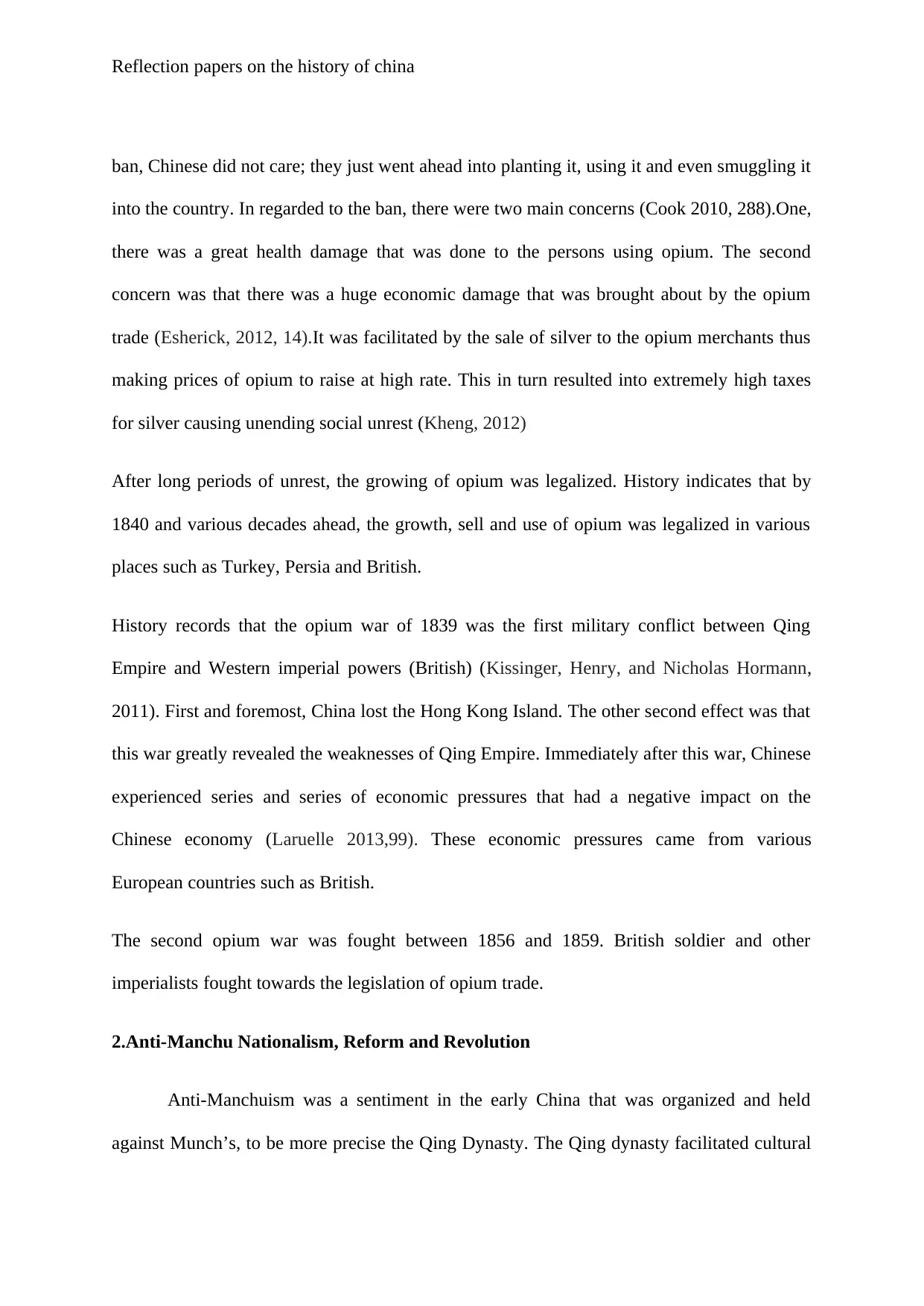
Reflection papers on the history of china
ban, Chinese did not care; they just went ahead into planting it, using it and even smuggling it
into the country. In regarded to the ban, there were two main concerns (Cook 2010, 288).One,
there was a great health damage that was done to the persons using opium. The second
concern was that there was a huge economic damage that was brought about by the opium
trade (Esherick, 2012, 14).It was facilitated by the sale of silver to the opium merchants thus
making prices of opium to raise at high rate. This in turn resulted into extremely high taxes
for silver causing unending social unrest (Kheng, 2012)
After long periods of unrest, the growing of opium was legalized. History indicates that by
1840 and various decades ahead, the growth, sell and use of opium was legalized in various
places such as Turkey, Persia and British.
History records that the opium war of 1839 was the first military conflict between Qing
Empire and Western imperial powers (British) (Kissinger, Henry, and Nicholas Hormann,
2011). First and foremost, China lost the Hong Kong Island. The other second effect was that
this war greatly revealed the weaknesses of Qing Empire. Immediately after this war, Chinese
experienced series and series of economic pressures that had a negative impact on the
Chinese economy (Laruelle 2013,99). These economic pressures came from various
European countries such as British.
The second opium war was fought between 1856 and 1859. British soldier and other
imperialists fought towards the legislation of opium trade.
2.Anti-Manchu Nationalism, Reform and Revolution
Anti-Manchuism was a sentiment in the early China that was organized and held
against Munch’s, to be more precise the Qing Dynasty. The Qing dynasty facilitated cultural
ban, Chinese did not care; they just went ahead into planting it, using it and even smuggling it
into the country. In regarded to the ban, there were two main concerns (Cook 2010, 288).One,
there was a great health damage that was done to the persons using opium. The second
concern was that there was a huge economic damage that was brought about by the opium
trade (Esherick, 2012, 14).It was facilitated by the sale of silver to the opium merchants thus
making prices of opium to raise at high rate. This in turn resulted into extremely high taxes
for silver causing unending social unrest (Kheng, 2012)
After long periods of unrest, the growing of opium was legalized. History indicates that by
1840 and various decades ahead, the growth, sell and use of opium was legalized in various
places such as Turkey, Persia and British.
History records that the opium war of 1839 was the first military conflict between Qing
Empire and Western imperial powers (British) (Kissinger, Henry, and Nicholas Hormann,
2011). First and foremost, China lost the Hong Kong Island. The other second effect was that
this war greatly revealed the weaknesses of Qing Empire. Immediately after this war, Chinese
experienced series and series of economic pressures that had a negative impact on the
Chinese economy (Laruelle 2013,99). These economic pressures came from various
European countries such as British.
The second opium war was fought between 1856 and 1859. British soldier and other
imperialists fought towards the legislation of opium trade.
2.Anti-Manchu Nationalism, Reform and Revolution
Anti-Manchuism was a sentiment in the early China that was organized and held
against Munch’s, to be more precise the Qing Dynasty. The Qing dynasty facilitated cultural
⊘ This is a preview!⊘
Do you want full access?
Subscribe today to unlock all pages.

Trusted by 1+ million students worldwide
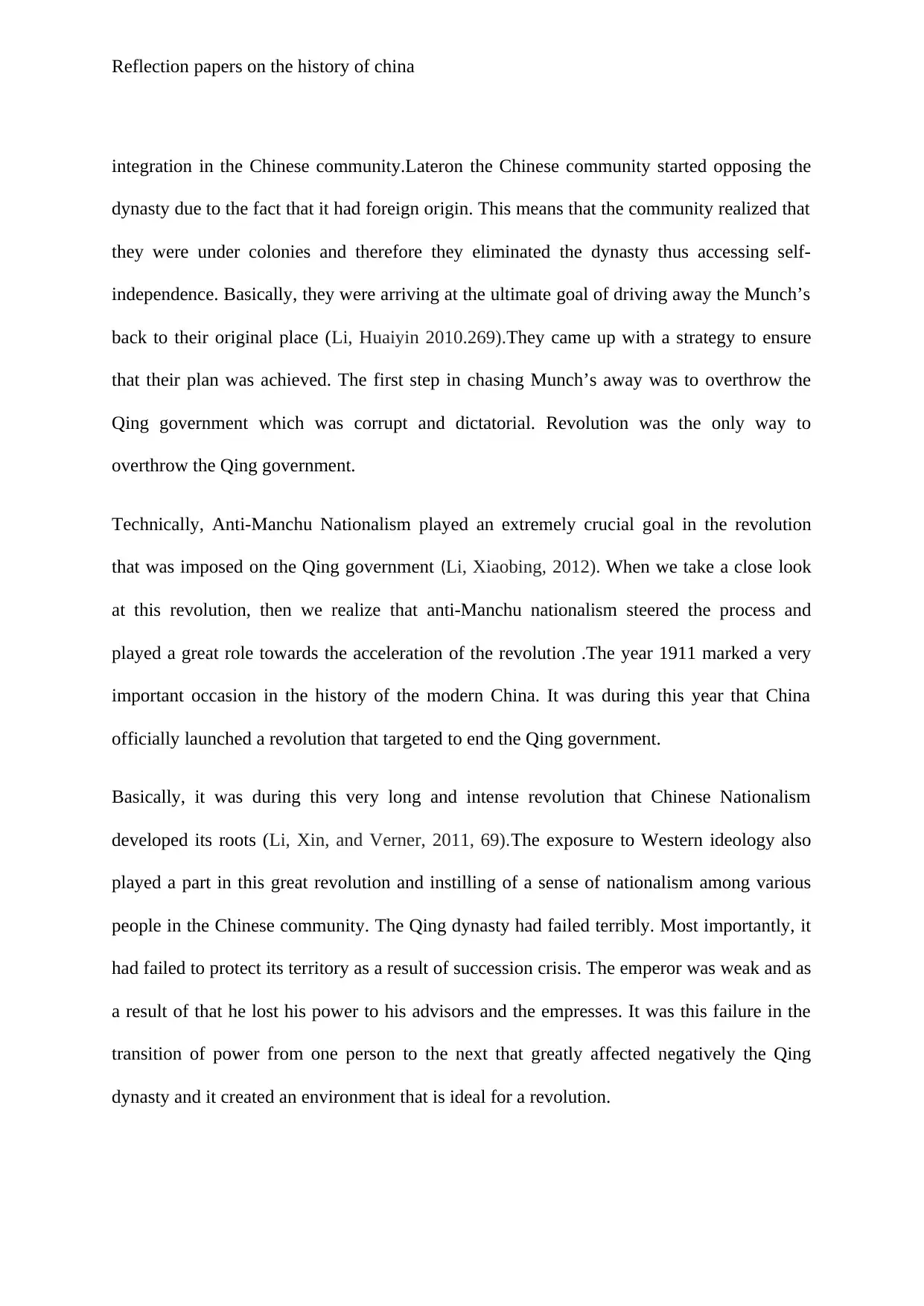
Reflection papers on the history of china
integration in the Chinese community.Lateron the Chinese community started opposing the
dynasty due to the fact that it had foreign origin. This means that the community realized that
they were under colonies and therefore they eliminated the dynasty thus accessing self-
independence. Basically, they were arriving at the ultimate goal of driving away the Munch’s
back to their original place (Li, Huaiyin 2010.269).They came up with a strategy to ensure
that their plan was achieved. The first step in chasing Munch’s away was to overthrow the
Qing government which was corrupt and dictatorial. Revolution was the only way to
overthrow the Qing government.
Technically, Anti-Manchu Nationalism played an extremely crucial goal in the revolution
that was imposed on the Qing government (Li, Xiaobing, 2012). When we take a close look
at this revolution, then we realize that anti-Manchu nationalism steered the process and
played a great role towards the acceleration of the revolution .The year 1911 marked a very
important occasion in the history of the modern China. It was during this year that China
officially launched a revolution that targeted to end the Qing government.
Basically, it was during this very long and intense revolution that Chinese Nationalism
developed its roots (Li, Xin, and Verner, 2011, 69).The exposure to Western ideology also
played a part in this great revolution and instilling of a sense of nationalism among various
people in the Chinese community. The Qing dynasty had failed terribly. Most importantly, it
had failed to protect its territory as a result of succession crisis. The emperor was weak and as
a result of that he lost his power to his advisors and the empresses. It was this failure in the
transition of power from one person to the next that greatly affected negatively the Qing
dynasty and it created an environment that is ideal for a revolution.
integration in the Chinese community.Lateron the Chinese community started opposing the
dynasty due to the fact that it had foreign origin. This means that the community realized that
they were under colonies and therefore they eliminated the dynasty thus accessing self-
independence. Basically, they were arriving at the ultimate goal of driving away the Munch’s
back to their original place (Li, Huaiyin 2010.269).They came up with a strategy to ensure
that their plan was achieved. The first step in chasing Munch’s away was to overthrow the
Qing government which was corrupt and dictatorial. Revolution was the only way to
overthrow the Qing government.
Technically, Anti-Manchu Nationalism played an extremely crucial goal in the revolution
that was imposed on the Qing government (Li, Xiaobing, 2012). When we take a close look
at this revolution, then we realize that anti-Manchu nationalism steered the process and
played a great role towards the acceleration of the revolution .The year 1911 marked a very
important occasion in the history of the modern China. It was during this year that China
officially launched a revolution that targeted to end the Qing government.
Basically, it was during this very long and intense revolution that Chinese Nationalism
developed its roots (Li, Xin, and Verner, 2011, 69).The exposure to Western ideology also
played a part in this great revolution and instilling of a sense of nationalism among various
people in the Chinese community. The Qing dynasty had failed terribly. Most importantly, it
had failed to protect its territory as a result of succession crisis. The emperor was weak and as
a result of that he lost his power to his advisors and the empresses. It was this failure in the
transition of power from one person to the next that greatly affected negatively the Qing
dynasty and it created an environment that is ideal for a revolution.
Paraphrase This Document
Need a fresh take? Get an instant paraphrase of this document with our AI Paraphraser
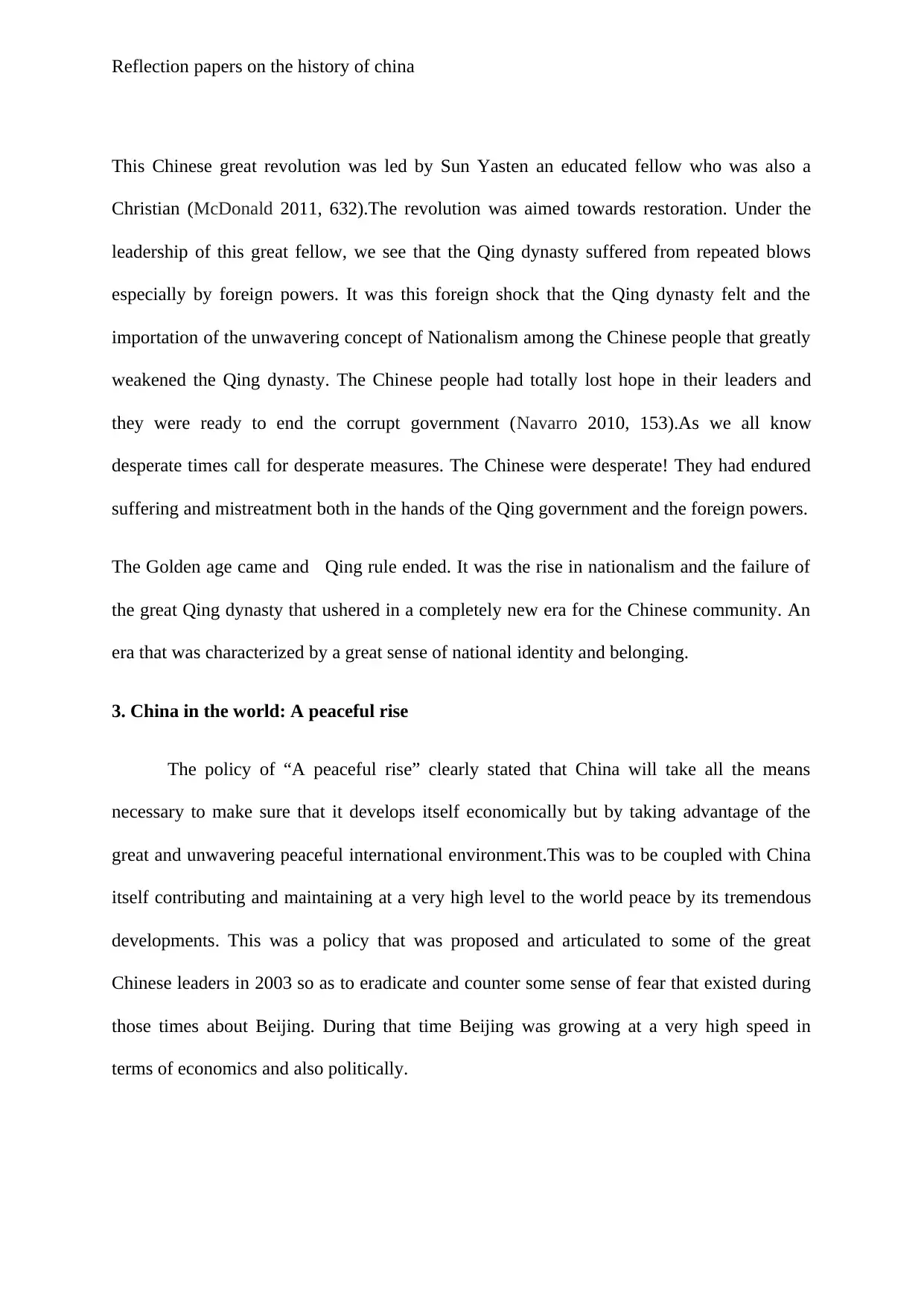
Reflection papers on the history of china
This Chinese great revolution was led by Sun Yasten an educated fellow who was also a
Christian (McDonald 2011, 632).The revolution was aimed towards restoration. Under the
leadership of this great fellow, we see that the Qing dynasty suffered from repeated blows
especially by foreign powers. It was this foreign shock that the Qing dynasty felt and the
importation of the unwavering concept of Nationalism among the Chinese people that greatly
weakened the Qing dynasty. The Chinese people had totally lost hope in their leaders and
they were ready to end the corrupt government (Navarro 2010, 153).As we all know
desperate times call for desperate measures. The Chinese were desperate! They had endured
suffering and mistreatment both in the hands of the Qing government and the foreign powers.
The Golden age came and Qing rule ended. It was the rise in nationalism and the failure of
the great Qing dynasty that ushered in a completely new era for the Chinese community. An
era that was characterized by a great sense of national identity and belonging.
3. China in the world: A peaceful rise
The policy of “A peaceful rise” clearly stated that China will take all the means
necessary to make sure that it develops itself economically but by taking advantage of the
great and unwavering peaceful international environment.This was to be coupled with China
itself contributing and maintaining at a very high level to the world peace by its tremendous
developments. This was a policy that was proposed and articulated to some of the great
Chinese leaders in 2003 so as to eradicate and counter some sense of fear that existed during
those times about Beijing. During that time Beijing was growing at a very high speed in
terms of economics and also politically.
This Chinese great revolution was led by Sun Yasten an educated fellow who was also a
Christian (McDonald 2011, 632).The revolution was aimed towards restoration. Under the
leadership of this great fellow, we see that the Qing dynasty suffered from repeated blows
especially by foreign powers. It was this foreign shock that the Qing dynasty felt and the
importation of the unwavering concept of Nationalism among the Chinese people that greatly
weakened the Qing dynasty. The Chinese people had totally lost hope in their leaders and
they were ready to end the corrupt government (Navarro 2010, 153).As we all know
desperate times call for desperate measures. The Chinese were desperate! They had endured
suffering and mistreatment both in the hands of the Qing government and the foreign powers.
The Golden age came and Qing rule ended. It was the rise in nationalism and the failure of
the great Qing dynasty that ushered in a completely new era for the Chinese community. An
era that was characterized by a great sense of national identity and belonging.
3. China in the world: A peaceful rise
The policy of “A peaceful rise” clearly stated that China will take all the means
necessary to make sure that it develops itself economically but by taking advantage of the
great and unwavering peaceful international environment.This was to be coupled with China
itself contributing and maintaining at a very high level to the world peace by its tremendous
developments. This was a policy that was proposed and articulated to some of the great
Chinese leaders in 2003 so as to eradicate and counter some sense of fear that existed during
those times about Beijing. During that time Beijing was growing at a very high speed in
terms of economics and also politically.
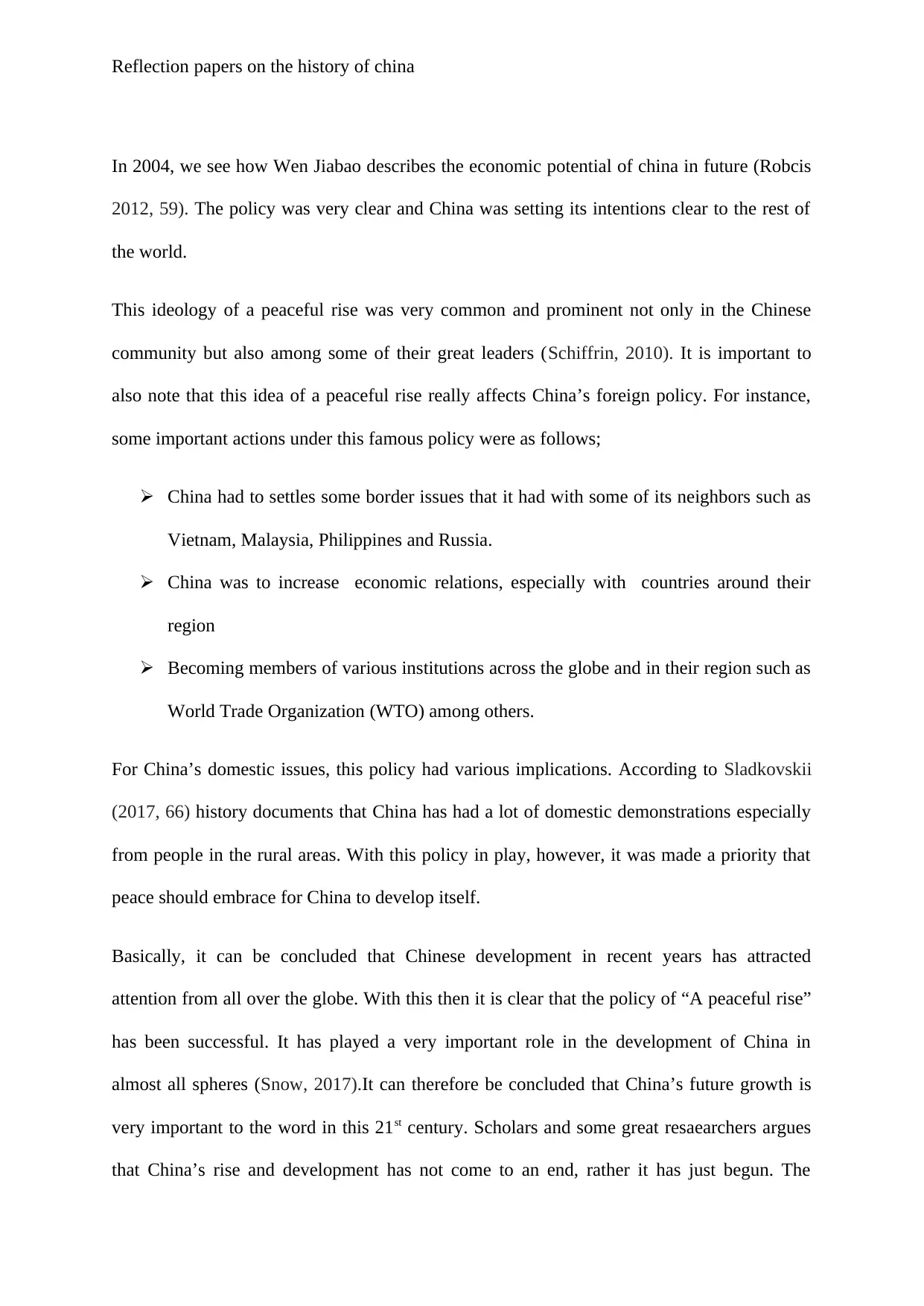
Reflection papers on the history of china
In 2004, we see how Wen Jiabao describes the economic potential of china in future (Robcis
2012, 59). The policy was very clear and China was setting its intentions clear to the rest of
the world.
This ideology of a peaceful rise was very common and prominent not only in the Chinese
community but also among some of their great leaders (Schiffrin, 2010). It is important to
also note that this idea of a peaceful rise really affects China’s foreign policy. For instance,
some important actions under this famous policy were as follows;
China had to settles some border issues that it had with some of its neighbors such as
Vietnam, Malaysia, Philippines and Russia.
China was to increase economic relations, especially with countries around their
region
Becoming members of various institutions across the globe and in their region such as
World Trade Organization (WTO) among others.
For China’s domestic issues, this policy had various implications. According to Sladkovskii
(2017, 66) history documents that China has had a lot of domestic demonstrations especially
from people in the rural areas. With this policy in play, however, it was made a priority that
peace should embrace for China to develop itself.
Basically, it can be concluded that Chinese development in recent years has attracted
attention from all over the globe. With this then it is clear that the policy of “A peaceful rise”
has been successful. It has played a very important role in the development of China in
almost all spheres (Snow, 2017).It can therefore be concluded that China’s future growth is
very important to the word in this 21st century. Scholars and some great resaearchers argues
that China’s rise and development has not come to an end, rather it has just begun. The
In 2004, we see how Wen Jiabao describes the economic potential of china in future (Robcis
2012, 59). The policy was very clear and China was setting its intentions clear to the rest of
the world.
This ideology of a peaceful rise was very common and prominent not only in the Chinese
community but also among some of their great leaders (Schiffrin, 2010). It is important to
also note that this idea of a peaceful rise really affects China’s foreign policy. For instance,
some important actions under this famous policy were as follows;
China had to settles some border issues that it had with some of its neighbors such as
Vietnam, Malaysia, Philippines and Russia.
China was to increase economic relations, especially with countries around their
region
Becoming members of various institutions across the globe and in their region such as
World Trade Organization (WTO) among others.
For China’s domestic issues, this policy had various implications. According to Sladkovskii
(2017, 66) history documents that China has had a lot of domestic demonstrations especially
from people in the rural areas. With this policy in play, however, it was made a priority that
peace should embrace for China to develop itself.
Basically, it can be concluded that Chinese development in recent years has attracted
attention from all over the globe. With this then it is clear that the policy of “A peaceful rise”
has been successful. It has played a very important role in the development of China in
almost all spheres (Snow, 2017).It can therefore be concluded that China’s future growth is
very important to the word in this 21st century. Scholars and some great resaearchers argues
that China’s rise and development has not come to an end, rather it has just begun. The
⊘ This is a preview!⊘
Do you want full access?
Subscribe today to unlock all pages.

Trusted by 1+ million students worldwide
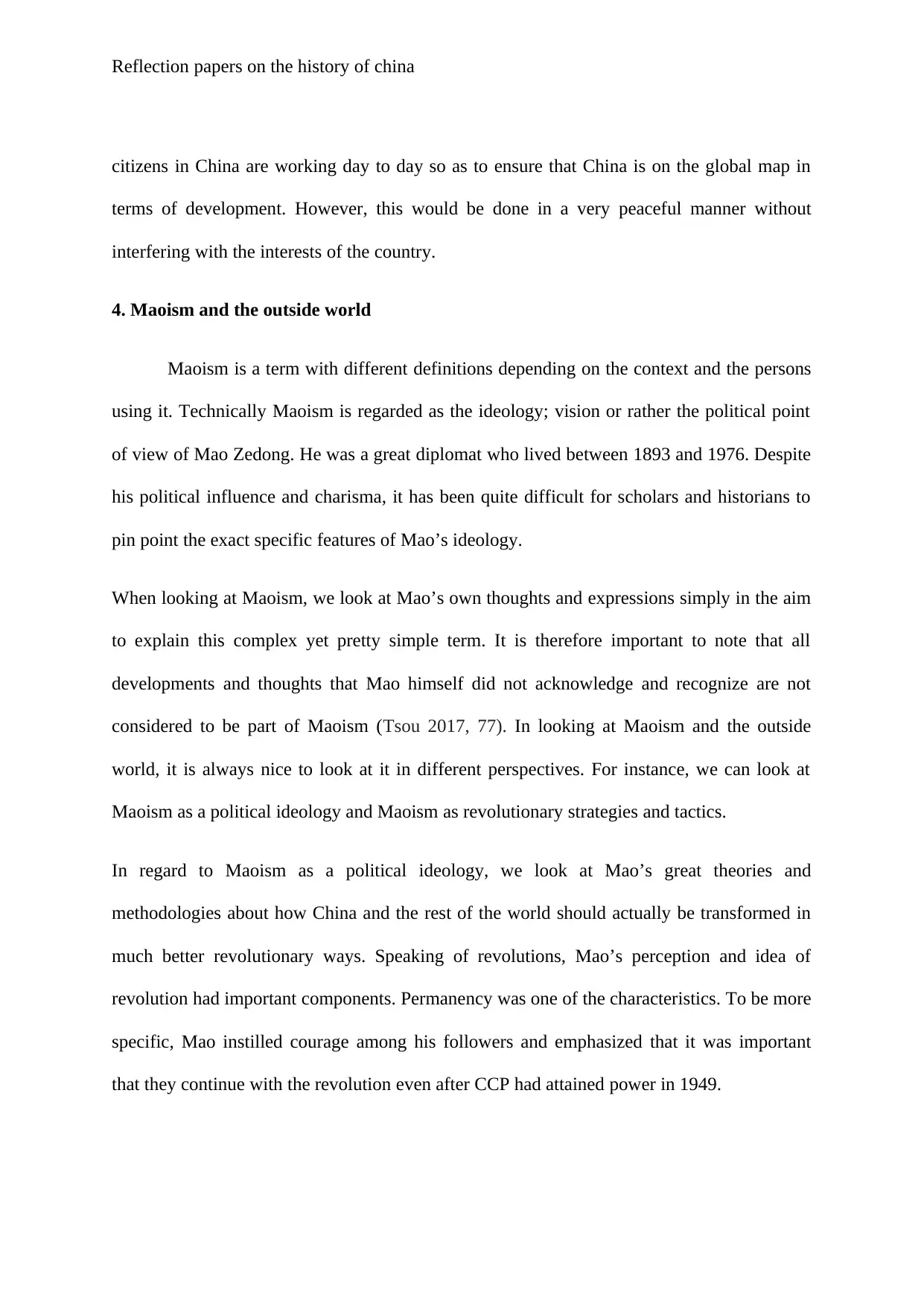
Reflection papers on the history of china
citizens in China are working day to day so as to ensure that China is on the global map in
terms of development. However, this would be done in a very peaceful manner without
interfering with the interests of the country.
4. Maoism and the outside world
Maoism is a term with different definitions depending on the context and the persons
using it. Technically Maoism is regarded as the ideology; vision or rather the political point
of view of Mao Zedong. He was a great diplomat who lived between 1893 and 1976. Despite
his political influence and charisma, it has been quite difficult for scholars and historians to
pin point the exact specific features of Mao’s ideology.
When looking at Maoism, we look at Mao’s own thoughts and expressions simply in the aim
to explain this complex yet pretty simple term. It is therefore important to note that all
developments and thoughts that Mao himself did not acknowledge and recognize are not
considered to be part of Maoism (Tsou 2017, 77). In looking at Maoism and the outside
world, it is always nice to look at it in different perspectives. For instance, we can look at
Maoism as a political ideology and Maoism as revolutionary strategies and tactics.
In regard to Maoism as a political ideology, we look at Mao’s great theories and
methodologies about how China and the rest of the world should actually be transformed in
much better revolutionary ways. Speaking of revolutions, Mao’s perception and idea of
revolution had important components. Permanency was one of the characteristics. To be more
specific, Mao instilled courage among his followers and emphasized that it was important
that they continue with the revolution even after CCP had attained power in 1949.
citizens in China are working day to day so as to ensure that China is on the global map in
terms of development. However, this would be done in a very peaceful manner without
interfering with the interests of the country.
4. Maoism and the outside world
Maoism is a term with different definitions depending on the context and the persons
using it. Technically Maoism is regarded as the ideology; vision or rather the political point
of view of Mao Zedong. He was a great diplomat who lived between 1893 and 1976. Despite
his political influence and charisma, it has been quite difficult for scholars and historians to
pin point the exact specific features of Mao’s ideology.
When looking at Maoism, we look at Mao’s own thoughts and expressions simply in the aim
to explain this complex yet pretty simple term. It is therefore important to note that all
developments and thoughts that Mao himself did not acknowledge and recognize are not
considered to be part of Maoism (Tsou 2017, 77). In looking at Maoism and the outside
world, it is always nice to look at it in different perspectives. For instance, we can look at
Maoism as a political ideology and Maoism as revolutionary strategies and tactics.
In regard to Maoism as a political ideology, we look at Mao’s great theories and
methodologies about how China and the rest of the world should actually be transformed in
much better revolutionary ways. Speaking of revolutions, Mao’s perception and idea of
revolution had important components. Permanency was one of the characteristics. To be more
specific, Mao instilled courage among his followers and emphasized that it was important
that they continue with the revolution even after CCP had attained power in 1949.
Paraphrase This Document
Need a fresh take? Get an instant paraphrase of this document with our AI Paraphraser
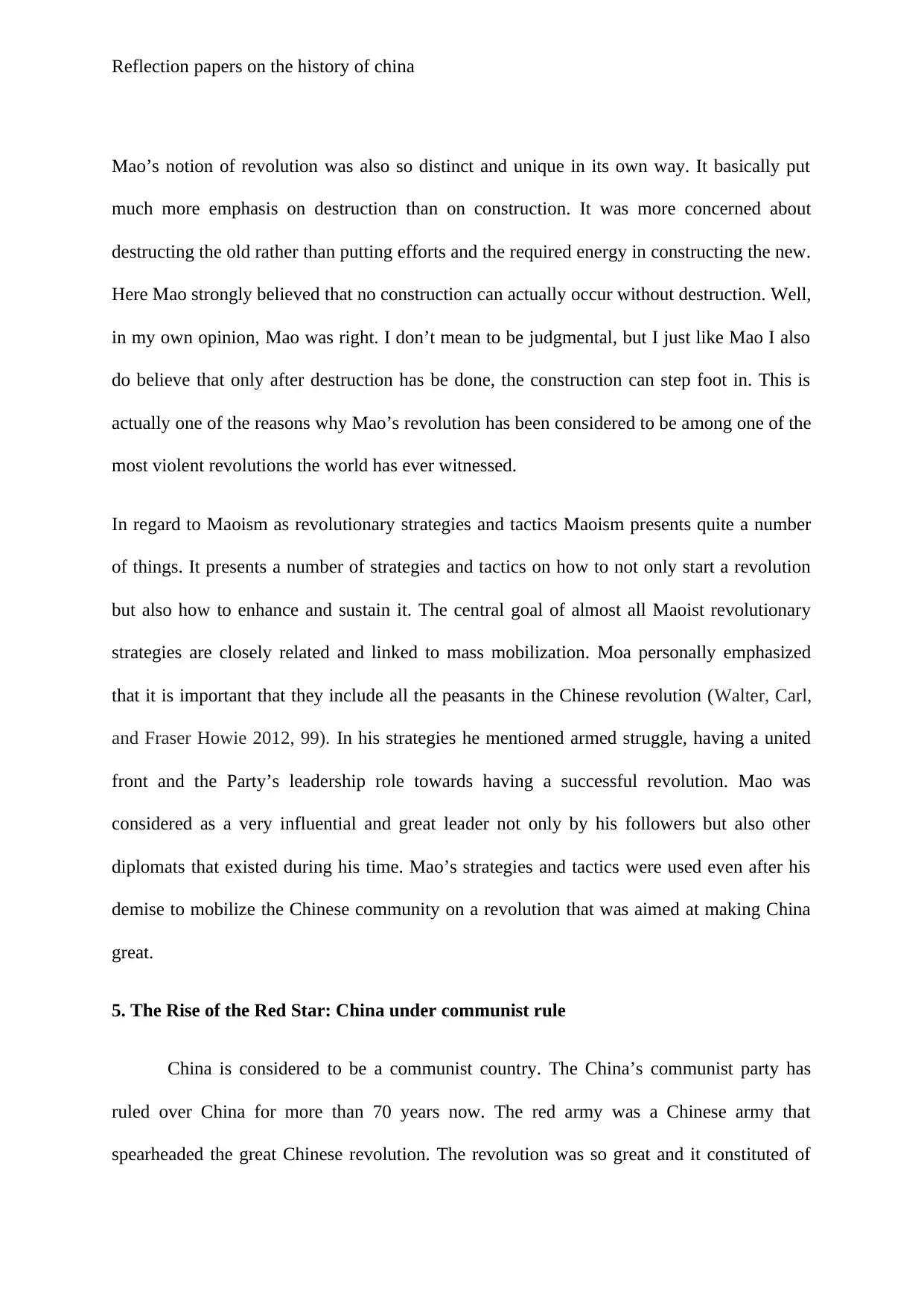
Reflection papers on the history of china
Mao’s notion of revolution was also so distinct and unique in its own way. It basically put
much more emphasis on destruction than on construction. It was more concerned about
destructing the old rather than putting efforts and the required energy in constructing the new.
Here Mao strongly believed that no construction can actually occur without destruction. Well,
in my own opinion, Mao was right. I don’t mean to be judgmental, but I just like Mao I also
do believe that only after destruction has be done, the construction can step foot in. This is
actually one of the reasons why Mao’s revolution has been considered to be among one of the
most violent revolutions the world has ever witnessed.
In regard to Maoism as revolutionary strategies and tactics Maoism presents quite a number
of things. It presents a number of strategies and tactics on how to not only start a revolution
but also how to enhance and sustain it. The central goal of almost all Maoist revolutionary
strategies are closely related and linked to mass mobilization. Moa personally emphasized
that it is important that they include all the peasants in the Chinese revolution (Walter, Carl,
and Fraser Howie 2012, 99). In his strategies he mentioned armed struggle, having a united
front and the Party’s leadership role towards having a successful revolution. Mao was
considered as a very influential and great leader not only by his followers but also other
diplomats that existed during his time. Mao’s strategies and tactics were used even after his
demise to mobilize the Chinese community on a revolution that was aimed at making China
great.
5. The Rise of the Red Star: China under communist rule
China is considered to be a communist country. The China’s communist party has
ruled over China for more than 70 years now. The red army was a Chinese army that
spearheaded the great Chinese revolution. The revolution was so great and it constituted of
Mao’s notion of revolution was also so distinct and unique in its own way. It basically put
much more emphasis on destruction than on construction. It was more concerned about
destructing the old rather than putting efforts and the required energy in constructing the new.
Here Mao strongly believed that no construction can actually occur without destruction. Well,
in my own opinion, Mao was right. I don’t mean to be judgmental, but I just like Mao I also
do believe that only after destruction has be done, the construction can step foot in. This is
actually one of the reasons why Mao’s revolution has been considered to be among one of the
most violent revolutions the world has ever witnessed.
In regard to Maoism as revolutionary strategies and tactics Maoism presents quite a number
of things. It presents a number of strategies and tactics on how to not only start a revolution
but also how to enhance and sustain it. The central goal of almost all Maoist revolutionary
strategies are closely related and linked to mass mobilization. Moa personally emphasized
that it is important that they include all the peasants in the Chinese revolution (Walter, Carl,
and Fraser Howie 2012, 99). In his strategies he mentioned armed struggle, having a united
front and the Party’s leadership role towards having a successful revolution. Mao was
considered as a very influential and great leader not only by his followers but also other
diplomats that existed during his time. Mao’s strategies and tactics were used even after his
demise to mobilize the Chinese community on a revolution that was aimed at making China
great.
5. The Rise of the Red Star: China under communist rule
China is considered to be a communist country. The China’s communist party has
ruled over China for more than 70 years now. The red army was a Chinese army that
spearheaded the great Chinese revolution. The revolution was so great and it constituted of
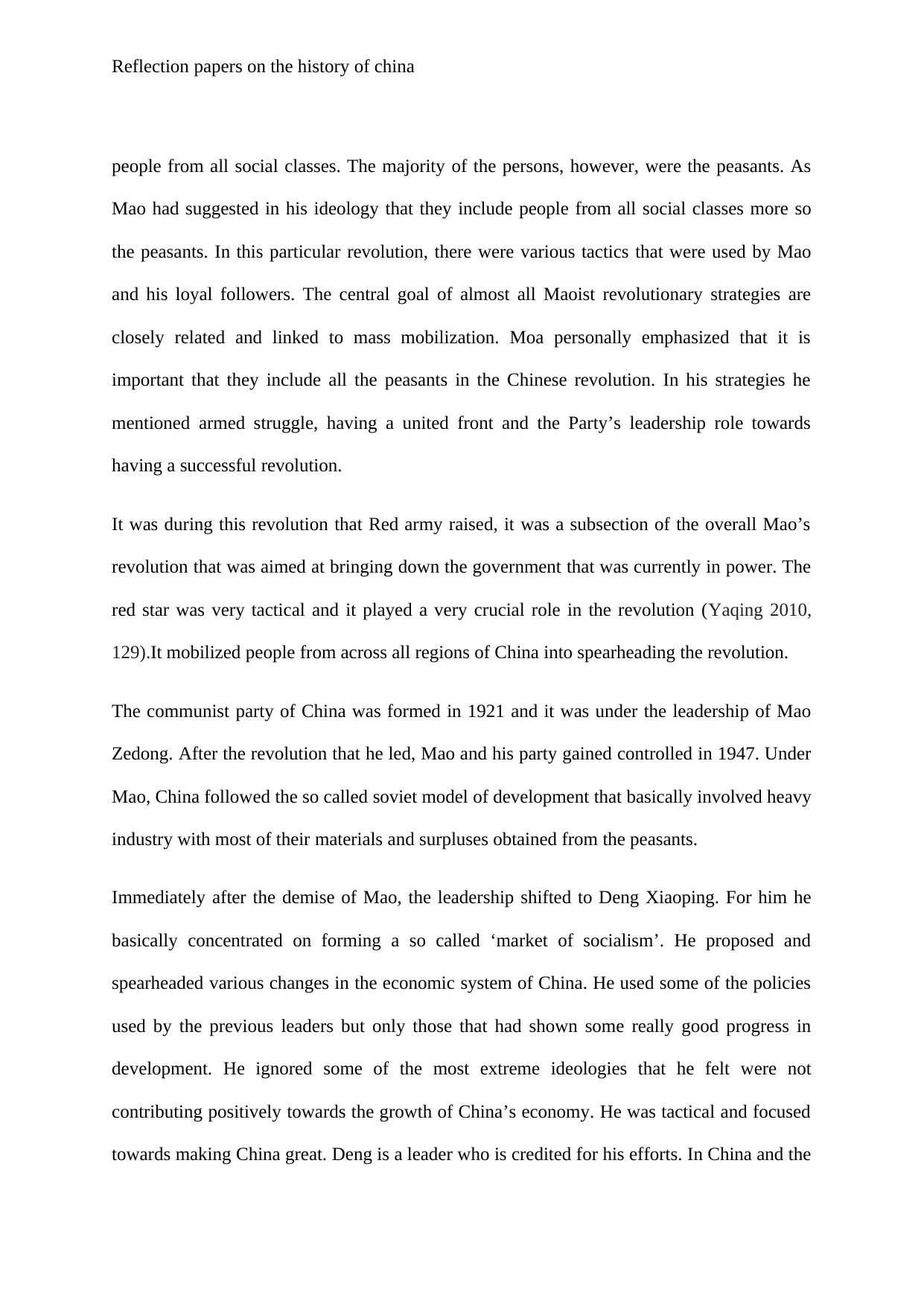
Reflection papers on the history of china
people from all social classes. The majority of the persons, however, were the peasants. As
Mao had suggested in his ideology that they include people from all social classes more so
the peasants. In this particular revolution, there were various tactics that were used by Mao
and his loyal followers. The central goal of almost all Maoist revolutionary strategies are
closely related and linked to mass mobilization. Moa personally emphasized that it is
important that they include all the peasants in the Chinese revolution. In his strategies he
mentioned armed struggle, having a united front and the Party’s leadership role towards
having a successful revolution.
It was during this revolution that Red army raised, it was a subsection of the overall Mao’s
revolution that was aimed at bringing down the government that was currently in power. The
red star was very tactical and it played a very crucial role in the revolution (Yaqing 2010,
129).It mobilized people from across all regions of China into spearheading the revolution.
The communist party of China was formed in 1921 and it was under the leadership of Mao
Zedong. After the revolution that he led, Mao and his party gained controlled in 1947. Under
Mao, China followed the so called soviet model of development that basically involved heavy
industry with most of their materials and surpluses obtained from the peasants.
Immediately after the demise of Mao, the leadership shifted to Deng Xiaoping. For him he
basically concentrated on forming a so called ‘market of socialism’. He proposed and
spearheaded various changes in the economic system of China. He used some of the policies
used by the previous leaders but only those that had shown some really good progress in
development. He ignored some of the most extreme ideologies that he felt were not
contributing positively towards the growth of China’s economy. He was tactical and focused
towards making China great. Deng is a leader who is credited for his efforts. In China and the
people from all social classes. The majority of the persons, however, were the peasants. As
Mao had suggested in his ideology that they include people from all social classes more so
the peasants. In this particular revolution, there were various tactics that were used by Mao
and his loyal followers. The central goal of almost all Maoist revolutionary strategies are
closely related and linked to mass mobilization. Moa personally emphasized that it is
important that they include all the peasants in the Chinese revolution. In his strategies he
mentioned armed struggle, having a united front and the Party’s leadership role towards
having a successful revolution.
It was during this revolution that Red army raised, it was a subsection of the overall Mao’s
revolution that was aimed at bringing down the government that was currently in power. The
red star was very tactical and it played a very crucial role in the revolution (Yaqing 2010,
129).It mobilized people from across all regions of China into spearheading the revolution.
The communist party of China was formed in 1921 and it was under the leadership of Mao
Zedong. After the revolution that he led, Mao and his party gained controlled in 1947. Under
Mao, China followed the so called soviet model of development that basically involved heavy
industry with most of their materials and surpluses obtained from the peasants.
Immediately after the demise of Mao, the leadership shifted to Deng Xiaoping. For him he
basically concentrated on forming a so called ‘market of socialism’. He proposed and
spearheaded various changes in the economic system of China. He used some of the policies
used by the previous leaders but only those that had shown some really good progress in
development. He ignored some of the most extreme ideologies that he felt were not
contributing positively towards the growth of China’s economy. He was tactical and focused
towards making China great. Deng is a leader who is credited for his efforts. In China and the
⊘ This is a preview!⊘
Do you want full access?
Subscribe today to unlock all pages.

Trusted by 1+ million students worldwide
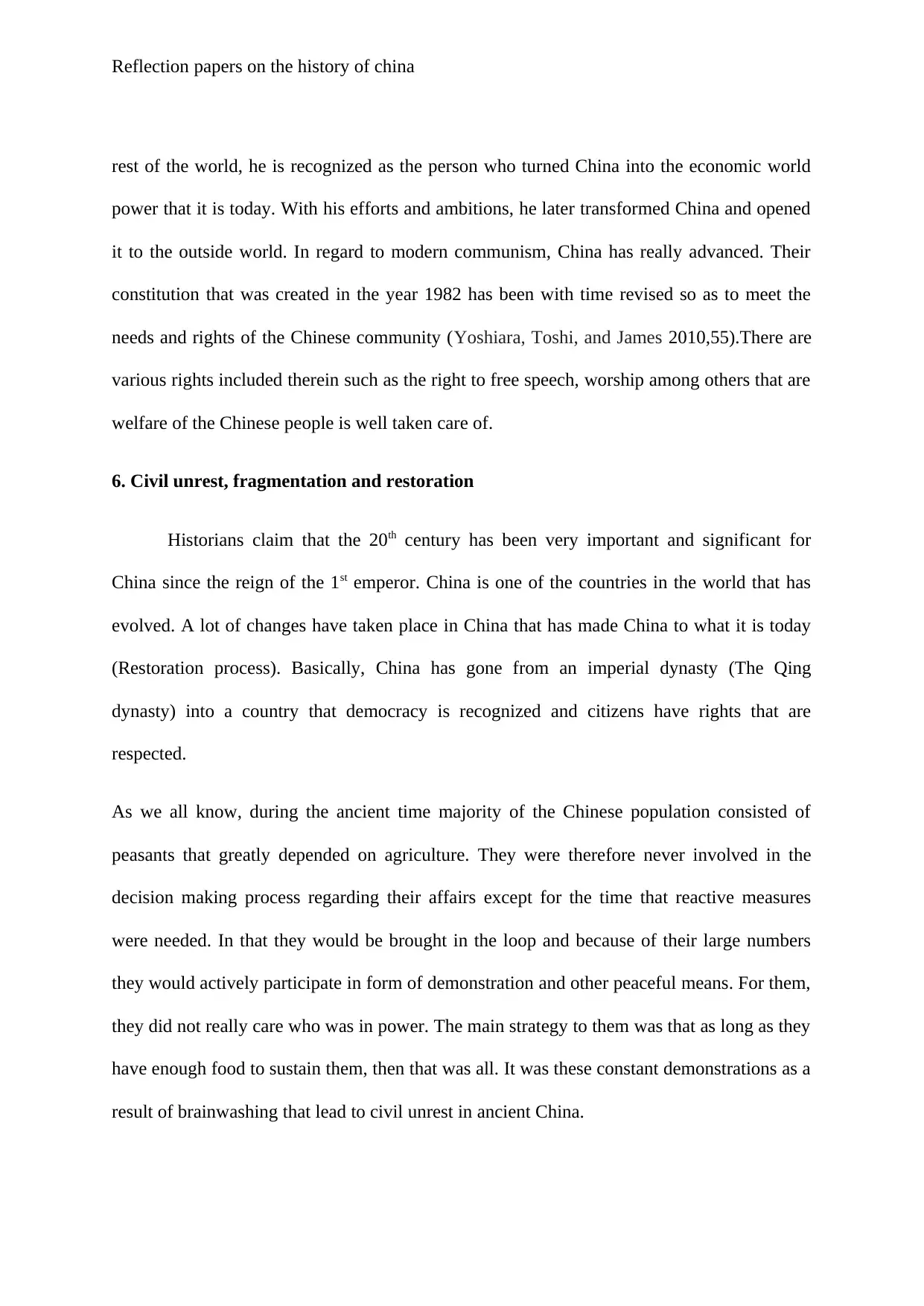
Reflection papers on the history of china
rest of the world, he is recognized as the person who turned China into the economic world
power that it is today. With his efforts and ambitions, he later transformed China and opened
it to the outside world. In regard to modern communism, China has really advanced. Their
constitution that was created in the year 1982 has been with time revised so as to meet the
needs and rights of the Chinese community (Yoshiara, Toshi, and James 2010,55).There are
various rights included therein such as the right to free speech, worship among others that are
welfare of the Chinese people is well taken care of.
6. Civil unrest, fragmentation and restoration
Historians claim that the 20th century has been very important and significant for
China since the reign of the 1st emperor. China is one of the countries in the world that has
evolved. A lot of changes have taken place in China that has made China to what it is today
(Restoration process). Basically, China has gone from an imperial dynasty (The Qing
dynasty) into a country that democracy is recognized and citizens have rights that are
respected.
As we all know, during the ancient time majority of the Chinese population consisted of
peasants that greatly depended on agriculture. They were therefore never involved in the
decision making process regarding their affairs except for the time that reactive measures
were needed. In that they would be brought in the loop and because of their large numbers
they would actively participate in form of demonstration and other peaceful means. For them,
they did not really care who was in power. The main strategy to them was that as long as they
have enough food to sustain them, then that was all. It was these constant demonstrations as a
result of brainwashing that lead to civil unrest in ancient China.
rest of the world, he is recognized as the person who turned China into the economic world
power that it is today. With his efforts and ambitions, he later transformed China and opened
it to the outside world. In regard to modern communism, China has really advanced. Their
constitution that was created in the year 1982 has been with time revised so as to meet the
needs and rights of the Chinese community (Yoshiara, Toshi, and James 2010,55).There are
various rights included therein such as the right to free speech, worship among others that are
welfare of the Chinese people is well taken care of.
6. Civil unrest, fragmentation and restoration
Historians claim that the 20th century has been very important and significant for
China since the reign of the 1st emperor. China is one of the countries in the world that has
evolved. A lot of changes have taken place in China that has made China to what it is today
(Restoration process). Basically, China has gone from an imperial dynasty (The Qing
dynasty) into a country that democracy is recognized and citizens have rights that are
respected.
As we all know, during the ancient time majority of the Chinese population consisted of
peasants that greatly depended on agriculture. They were therefore never involved in the
decision making process regarding their affairs except for the time that reactive measures
were needed. In that they would be brought in the loop and because of their large numbers
they would actively participate in form of demonstration and other peaceful means. For them,
they did not really care who was in power. The main strategy to them was that as long as they
have enough food to sustain them, then that was all. It was these constant demonstrations as a
result of brainwashing that lead to civil unrest in ancient China.
Paraphrase This Document
Need a fresh take? Get an instant paraphrase of this document with our AI Paraphraser
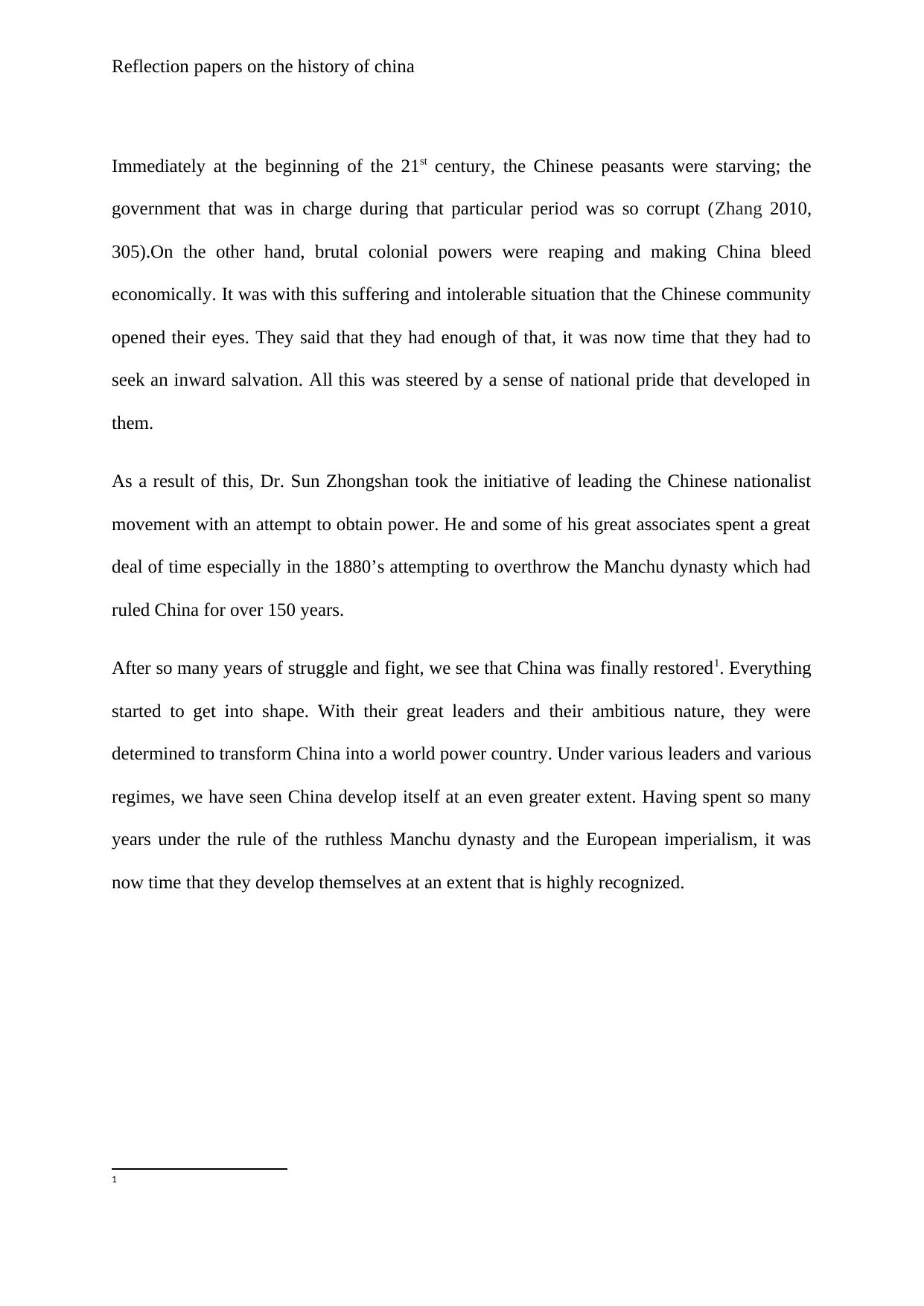
Reflection papers on the history of china
Immediately at the beginning of the 21st century, the Chinese peasants were starving; the
government that was in charge during that particular period was so corrupt (Zhang 2010,
305).On the other hand, brutal colonial powers were reaping and making China bleed
economically. It was with this suffering and intolerable situation that the Chinese community
opened their eyes. They said that they had enough of that, it was now time that they had to
seek an inward salvation. All this was steered by a sense of national pride that developed in
them.
As a result of this, Dr. Sun Zhongshan took the initiative of leading the Chinese nationalist
movement with an attempt to obtain power. He and some of his great associates spent a great
deal of time especially in the 1880’s attempting to overthrow the Manchu dynasty which had
ruled China for over 150 years.
After so many years of struggle and fight, we see that China was finally restored1. Everything
started to get into shape. With their great leaders and their ambitious nature, they were
determined to transform China into a world power country. Under various leaders and various
regimes, we have seen China develop itself at an even greater extent. Having spent so many
years under the rule of the ruthless Manchu dynasty and the European imperialism, it was
now time that they develop themselves at an extent that is highly recognized.
1
Immediately at the beginning of the 21st century, the Chinese peasants were starving; the
government that was in charge during that particular period was so corrupt (Zhang 2010,
305).On the other hand, brutal colonial powers were reaping and making China bleed
economically. It was with this suffering and intolerable situation that the Chinese community
opened their eyes. They said that they had enough of that, it was now time that they had to
seek an inward salvation. All this was steered by a sense of national pride that developed in
them.
As a result of this, Dr. Sun Zhongshan took the initiative of leading the Chinese nationalist
movement with an attempt to obtain power. He and some of his great associates spent a great
deal of time especially in the 1880’s attempting to overthrow the Manchu dynasty which had
ruled China for over 150 years.
After so many years of struggle and fight, we see that China was finally restored1. Everything
started to get into shape. With their great leaders and their ambitious nature, they were
determined to transform China into a world power country. Under various leaders and various
regimes, we have seen China develop itself at an even greater extent. Having spent so many
years under the rule of the ruthless Manchu dynasty and the European imperialism, it was
now time that they develop themselves at an extent that is highly recognized.
1
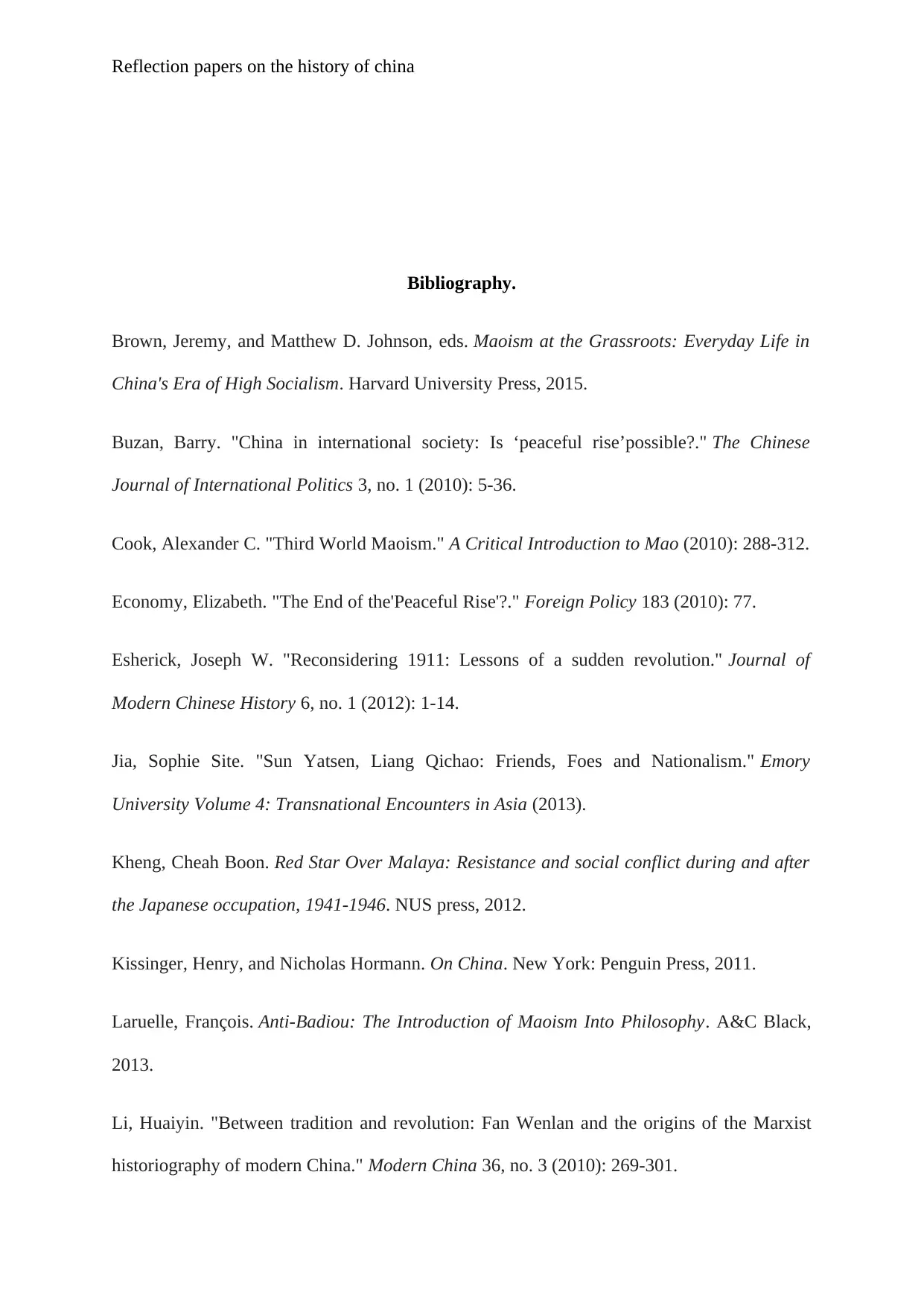
Reflection papers on the history of china
Bibliography.
Brown, Jeremy, and Matthew D. Johnson, eds. Maoism at the Grassroots: Everyday Life in
China's Era of High Socialism. Harvard University Press, 2015.
Buzan, Barry. "China in international society: Is ‘peaceful rise’possible?." The Chinese
Journal of International Politics 3, no. 1 (2010): 5-36.
Cook, Alexander C. "Third World Maoism." A Critical Introduction to Mao (2010): 288-312.
Economy, Elizabeth. "The End of the'Peaceful Rise'?." Foreign Policy 183 (2010): 77.
Esherick, Joseph W. "Reconsidering 1911: Lessons of a sudden revolution." Journal of
Modern Chinese History 6, no. 1 (2012): 1-14.
Jia, Sophie Site. "Sun Yatsen, Liang Qichao: Friends, Foes and Nationalism." Emory
University Volume 4: Transnational Encounters in Asia (2013).
Kheng, Cheah Boon. Red Star Over Malaya: Resistance and social conflict during and after
the Japanese occupation, 1941-1946. NUS press, 2012.
Kissinger, Henry, and Nicholas Hormann. On China. New York: Penguin Press, 2011.
Laruelle, François. Anti-Badiou: The Introduction of Maoism Into Philosophy. A&C Black,
2013.
Li, Huaiyin. "Between tradition and revolution: Fan Wenlan and the origins of the Marxist
historiography of modern China." Modern China 36, no. 3 (2010): 269-301.
Bibliography.
Brown, Jeremy, and Matthew D. Johnson, eds. Maoism at the Grassroots: Everyday Life in
China's Era of High Socialism. Harvard University Press, 2015.
Buzan, Barry. "China in international society: Is ‘peaceful rise’possible?." The Chinese
Journal of International Politics 3, no. 1 (2010): 5-36.
Cook, Alexander C. "Third World Maoism." A Critical Introduction to Mao (2010): 288-312.
Economy, Elizabeth. "The End of the'Peaceful Rise'?." Foreign Policy 183 (2010): 77.
Esherick, Joseph W. "Reconsidering 1911: Lessons of a sudden revolution." Journal of
Modern Chinese History 6, no. 1 (2012): 1-14.
Jia, Sophie Site. "Sun Yatsen, Liang Qichao: Friends, Foes and Nationalism." Emory
University Volume 4: Transnational Encounters in Asia (2013).
Kheng, Cheah Boon. Red Star Over Malaya: Resistance and social conflict during and after
the Japanese occupation, 1941-1946. NUS press, 2012.
Kissinger, Henry, and Nicholas Hormann. On China. New York: Penguin Press, 2011.
Laruelle, François. Anti-Badiou: The Introduction of Maoism Into Philosophy. A&C Black,
2013.
Li, Huaiyin. "Between tradition and revolution: Fan Wenlan and the origins of the Marxist
historiography of modern China." Modern China 36, no. 3 (2010): 269-301.
⊘ This is a preview!⊘
Do you want full access?
Subscribe today to unlock all pages.

Trusted by 1+ million students worldwide
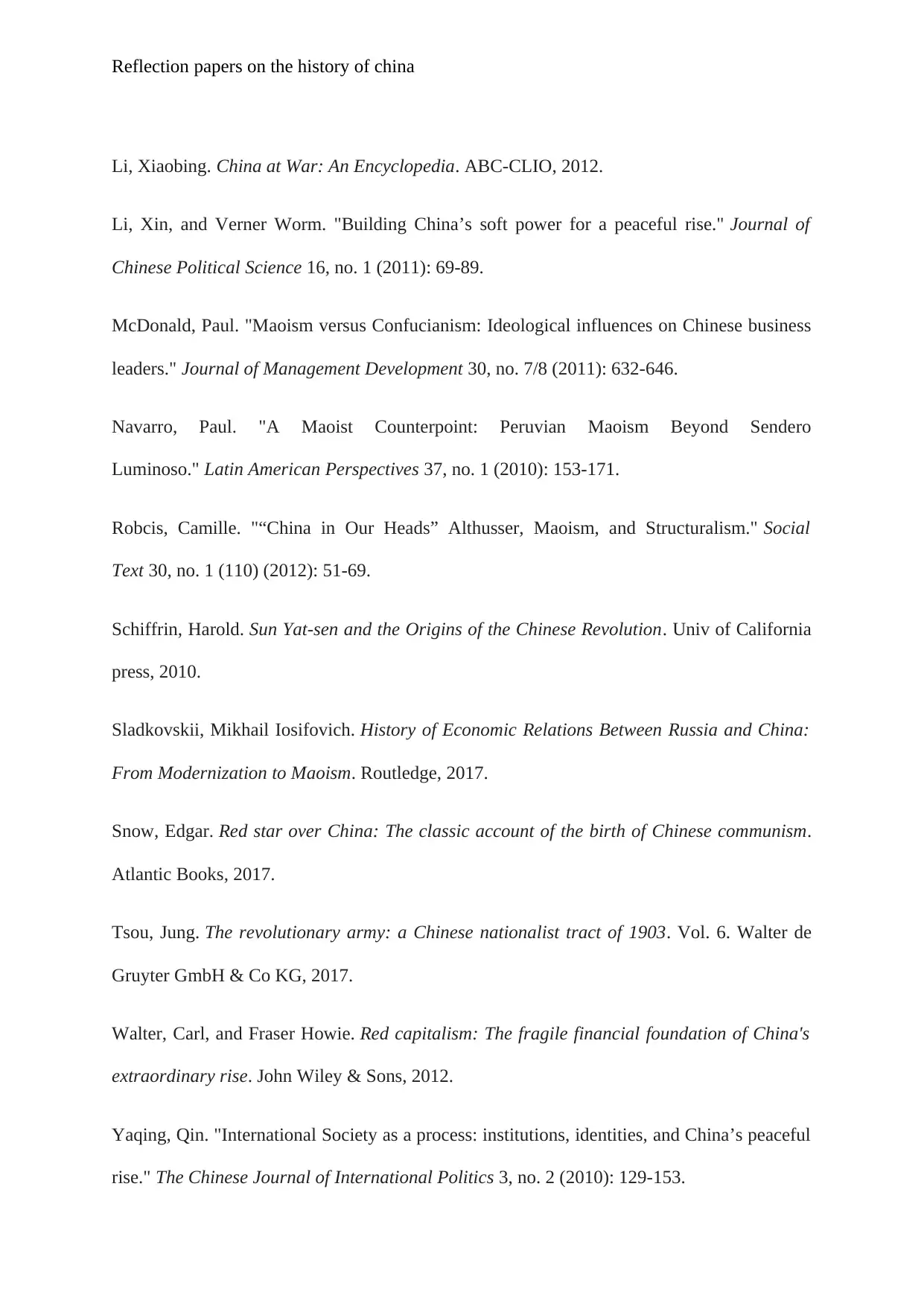
Reflection papers on the history of china
Li, Xiaobing. China at War: An Encyclopedia. ABC-CLIO, 2012.
Li, Xin, and Verner Worm. "Building China’s soft power for a peaceful rise." Journal of
Chinese Political Science 16, no. 1 (2011): 69-89.
McDonald, Paul. "Maoism versus Confucianism: Ideological influences on Chinese business
leaders." Journal of Management Development 30, no. 7/8 (2011): 632-646.
Navarro, Paul. "A Maoist Counterpoint: Peruvian Maoism Beyond Sendero
Luminoso." Latin American Perspectives 37, no. 1 (2010): 153-171.
Robcis, Camille. "“China in Our Heads” Althusser, Maoism, and Structuralism." Social
Text 30, no. 1 (110) (2012): 51-69.
Schiffrin, Harold. Sun Yat-sen and the Origins of the Chinese Revolution. Univ of California
press, 2010.
Sladkovskii, Mikhail Iosifovich. History of Economic Relations Between Russia and China:
From Modernization to Maoism. Routledge, 2017.
Snow, Edgar. Red star over China: The classic account of the birth of Chinese communism.
Atlantic Books, 2017.
Tsou, Jung. The revolutionary army: a Chinese nationalist tract of 1903. Vol. 6. Walter de
Gruyter GmbH & Co KG, 2017.
Walter, Carl, and Fraser Howie. Red capitalism: The fragile financial foundation of China's
extraordinary rise. John Wiley & Sons, 2012.
Yaqing, Qin. "International Society as a process: institutions, identities, and China’s peaceful
rise." The Chinese Journal of International Politics 3, no. 2 (2010): 129-153.
Li, Xiaobing. China at War: An Encyclopedia. ABC-CLIO, 2012.
Li, Xin, and Verner Worm. "Building China’s soft power for a peaceful rise." Journal of
Chinese Political Science 16, no. 1 (2011): 69-89.
McDonald, Paul. "Maoism versus Confucianism: Ideological influences on Chinese business
leaders." Journal of Management Development 30, no. 7/8 (2011): 632-646.
Navarro, Paul. "A Maoist Counterpoint: Peruvian Maoism Beyond Sendero
Luminoso." Latin American Perspectives 37, no. 1 (2010): 153-171.
Robcis, Camille. "“China in Our Heads” Althusser, Maoism, and Structuralism." Social
Text 30, no. 1 (110) (2012): 51-69.
Schiffrin, Harold. Sun Yat-sen and the Origins of the Chinese Revolution. Univ of California
press, 2010.
Sladkovskii, Mikhail Iosifovich. History of Economic Relations Between Russia and China:
From Modernization to Maoism. Routledge, 2017.
Snow, Edgar. Red star over China: The classic account of the birth of Chinese communism.
Atlantic Books, 2017.
Tsou, Jung. The revolutionary army: a Chinese nationalist tract of 1903. Vol. 6. Walter de
Gruyter GmbH & Co KG, 2017.
Walter, Carl, and Fraser Howie. Red capitalism: The fragile financial foundation of China's
extraordinary rise. John Wiley & Sons, 2012.
Yaqing, Qin. "International Society as a process: institutions, identities, and China’s peaceful
rise." The Chinese Journal of International Politics 3, no. 2 (2010): 129-153.
Paraphrase This Document
Need a fresh take? Get an instant paraphrase of this document with our AI Paraphraser
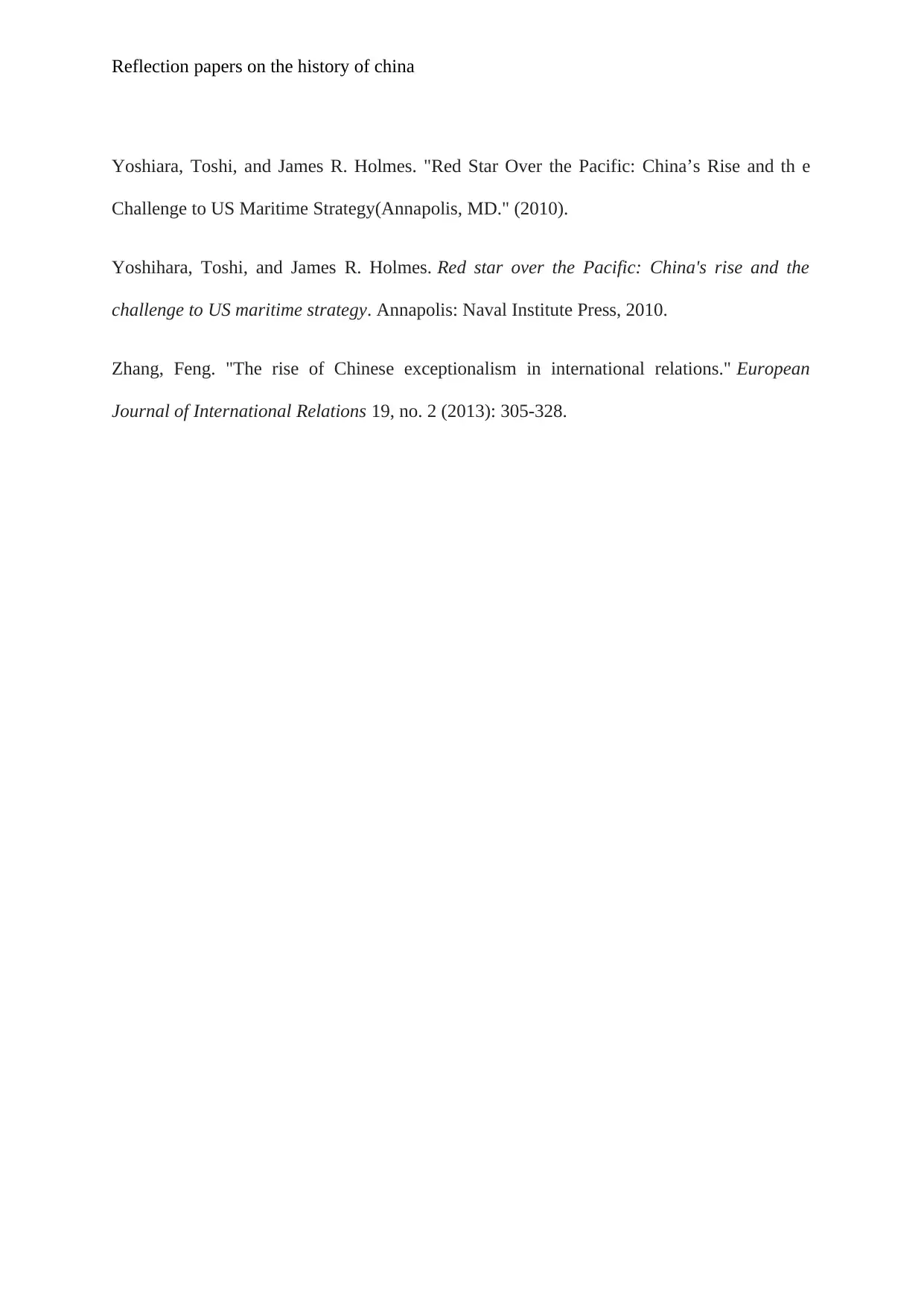
Reflection papers on the history of china
Yoshiara, Toshi, and James R. Holmes. "Red Star Over the Pacific: China’s Rise and th e
Challenge to US Maritime Strategy(Annapolis, MD." (2010).
Yoshihara, Toshi, and James R. Holmes. Red star over the Pacific: China's rise and the
challenge to US maritime strategy. Annapolis: Naval Institute Press, 2010.
Zhang, Feng. "The rise of Chinese exceptionalism in international relations." European
Journal of International Relations 19, no. 2 (2013): 305-328.
Yoshiara, Toshi, and James R. Holmes. "Red Star Over the Pacific: China’s Rise and th e
Challenge to US Maritime Strategy(Annapolis, MD." (2010).
Yoshihara, Toshi, and James R. Holmes. Red star over the Pacific: China's rise and the
challenge to US maritime strategy. Annapolis: Naval Institute Press, 2010.
Zhang, Feng. "The rise of Chinese exceptionalism in international relations." European
Journal of International Relations 19, no. 2 (2013): 305-328.
1 out of 14
Your All-in-One AI-Powered Toolkit for Academic Success.
+13062052269
info@desklib.com
Available 24*7 on WhatsApp / Email
![[object Object]](/_next/static/media/star-bottom.7253800d.svg)
Unlock your academic potential
© 2024 | Zucol Services PVT LTD | All rights reserved.
